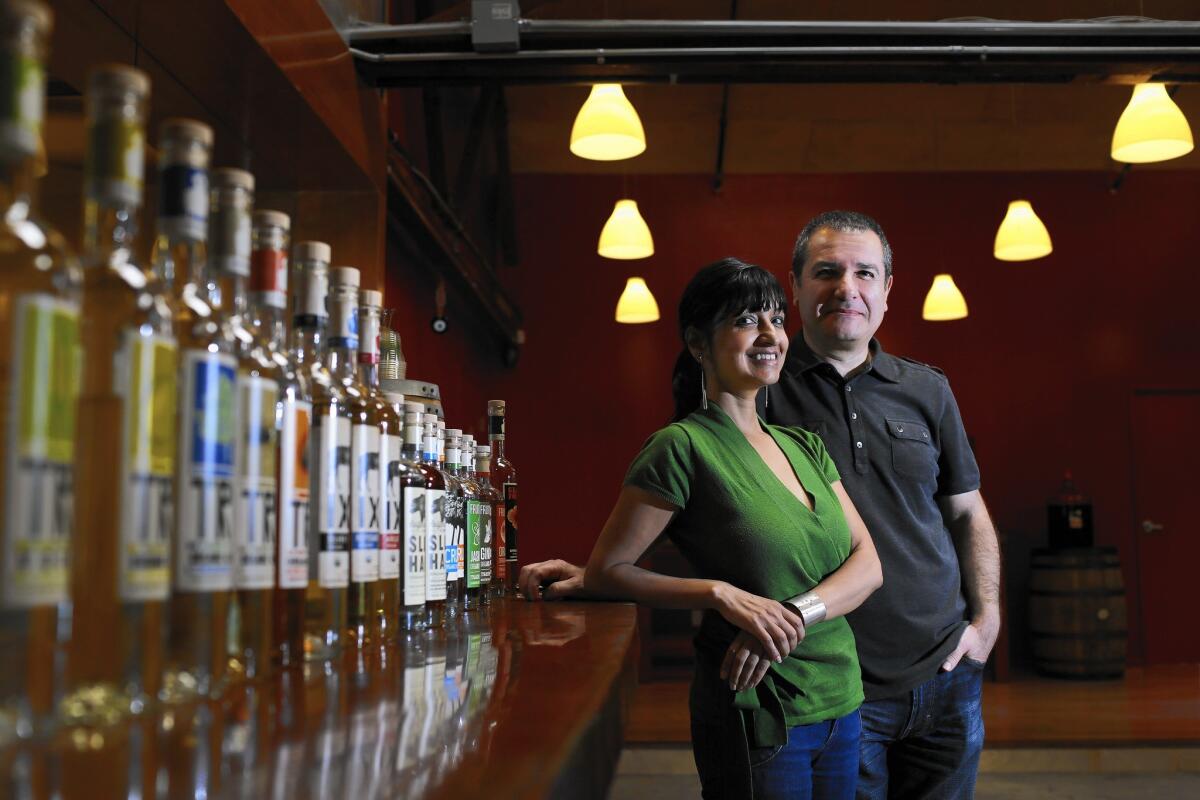California distilleries get into spirits of handcrafting

The Greenbar Craft Distillery near downtown Los Angelest was founded 11 years ago by Litty Mathew, left, and Melkon Khosrovian when a hobby turned into a career for them.
- Share via
Greenbar Craft Distillery’s Grand Poppy organic aperitive was inspired by hikes in Griffith Park and created with local, organic ingredients that pay homage to Southern California.
The Los Angeles distillery’s California connection is paying off — over its 11 years in business, the distillery has developed a unique lineup of organic, handcrafted spirits, including vodka, gin, whiskey and rum. Husband and wife founders Melkon Khosrovian and Litty Mathew say they don’t worry about faithfully reproducing centuries-old European recipes. They only care about taste.
Mathew winked. “We’re not very traditional.”
In the midst of a Renaissance for carefully crafted spirits, artisan distilleries like Greenbar have boomed in California and across the nation — there are now nearly 800, up from only about a dozen in 2000. California, home to at least 75 craft spirit makers, has been a pioneer in this expansion.
These pricier artisan spirits are a growing niche of the $60-billion U.S. spirits market, with 2% of sales last year, according to the American Craft Spirits Assn. The volume of craft spirits produced has nearly doubled in the last two years, the trade group said.
A new law signed last week by Gov. Jerry Brown could push California craft distillers even more mainstream. The Craft Distillers Act of 2015 allows spirits makers to sell up to three bottles of their alcohol from tasting rooms and operate an on-site bar and restaurant for the first time.
“There will be an explosion of more and more small distillers,” said Lance Winters, master distiller at Alameda, Calif.-based St. George Spirits, the first craft distillery in the nation. “Hopefully because of the fact that there will be a lot of competition, people will be really working hard to differentiate themselves from one another.”
The industry has changed dramatically over the last two decades as consumer preferences changed.
“When I first started distilling, people were predominantly drinking wine coolers,” Winters said. “In an era when white wine is just too hard-core to drink, there’s not a lot of hope for a distiller to carve out a living.”
Then about 15 years ago, spirit-driven cocktails became popular. These drinks showcased the sharp taste of distilled liquor rather than hiding it in a bevy of other ingredients.
Momentum continued to build, Winters said, as more customers turned to local sources for food and expected the same from their spirits, leading to greater demand for craft distillers. The surging interest in craft beer doesn’t hurt, either.
Craft brews have continued to outperform the overall U.S. beer market and now represent 11% of total volume. California alone has nearly 600 craft breweries, according to the California Craft Brewers Assn.
Many craft distillers started off as craft brewers and ventured into spirits-making to further challenge themselves.
“What is whiskey but distilled beer without the hops,” said Andrew Faulkner, vice president of the American Distilling Institute, a trade organization for craft distillers.
Whiskey is the most popular spirit — 37% of craft distillers produced it last year, according to the American Craft Spirits Assn., a trade group. Craft producers often while away the time it takes to age whiskey by expanding their production to gin, produced by 13% of craft distillers last year, and vodka, which trailed at 12%.
Stark Spirits in Pasadena chose to focus on rum and brandy while its single malt whiskey aged in barrels. The microdistillery has only two full-time employees — husband and wife Greg Stark and Karen Robinson-Stark — who do everything from distilling to hand labeling and signing bottles.
Though the distillery opened less than a year ago, its products can already be found in more than 30 California restaurants and retailers. Their specialty is a 100-proof orange brandy called Sunshine that’s made from locally grown citrus fruits.
“It’s fun, and it’s ours,” Robinson-Stark said.
In California, there are at least 75 craft spirit manufacturers, up from the five to 10 that were in business in 2000, said Cris Steller, executive director of the California Artisanal Distillers Guild.
Much of the action is happening in Northern California, home of craft distilling pioneers such as St. George Spirits and related industries like craft brewing and winemaking.
“The growth in California, I think, is due to the fact that we grow so much here,” Steller said. “Between the beer industry and the wine industry, that creative momentum just grew into distilling.”
Advocates say direct-to-consumer sales could help California catch up with Washington, Oregon and New York, which have outstripped the Golden State in spirits production and number of distilleries.
Brian Christenson is ready to take on the challenge in Southern California. A former art director at an advertising agency, Christenson decided to turn his interest in craft brewing and spirit-making into a new career.
His Santa Ana distillery, Blinking Owl, should be fully operational by early 2016 and will produce vodka, gin and a Scandinavian spirit called aquavit, similar to gin and flavored with dill and caraway.
“Orange County is the last frontier, just because there isn’t anybody,” Christenson said. “There definitely is a need.”
Khosrovian and Mathew of Greenbar saw the same opportunity when they first emerged on the craft spirits scene in 2004 as the 38th craft distillery in the nation.
“Lots of companies in the Midwest or the East Coast were trying to capture a bygone era,” Khosrovian said. “You find very few companies trying to relive the past in California.”
Twitter: @smasunaga
More to Read
Inside the business of entertainment
The Wide Shot brings you news, analysis and insights on everything from streaming wars to production — and what it all means for the future.
You may occasionally receive promotional content from the Los Angeles Times.











